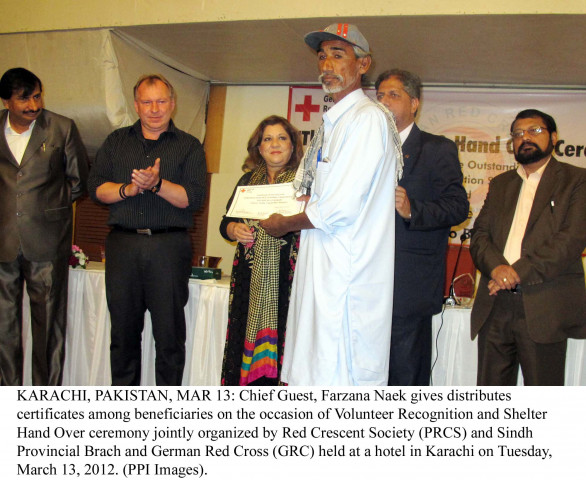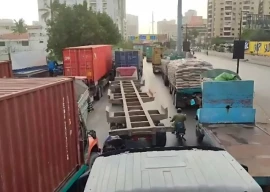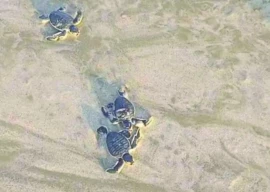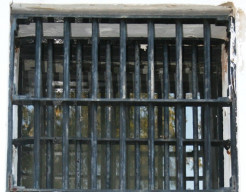
Up to 134 shelters for flood survivors have been completed and handed over by the Pakistan Red Crescent Society - Sindh (PRCS-S) in collaboration with the German Red Cross (GRC).
Hit by floods in 2011 and struggling with donor fatigue and scant media coverage, flood survivors in Thatta and Badin have been slowly trying to return to a normal life.
“We have been given so much money by international donors before, one million pounds from the British Red Cross, but everyone is also wondering where the money is going,” says PRCS-S Chairperson Farzhana Naek. “They want to see profiles raised before they give any more money to organisations.”
A ceremony was held at Beach Luxury hotel in Karachi on Tuesday to honour those involved in the project. It was attended by PRCS-S Vice-Chairman Raffique Ahmed Jafferi, PRCS-S Honorary Treasurer Jalal Sheikh, PRCS-S Provincial Secretary Kanwar Naseem, GRC Country Head Dirk Kamm and GRC Country programme manager Atta Muhammad Durrani.
Work on the shelters began in September 2011 at a cost of approximately 200,000 rupees per shelter.
The fifteen to twenty areas where completed shelters are being handed over are all located in coastal villages in Thatta and there are another 166 shelters that are expected to be completed by July for villages in Badin.
“We had to concentrate so much on relief and dealing with livelihood and health programmes before but we have to focus on recovery instead of just emergency and relief operations,” said Naek.
There are varying estimates of how many people have been displaced. A recent report by the People’s Accountability Commission on Floods puts the figure at no less than 50,000, until February.
“There is a lengthy process involved and it also depends on how big the project is,” says GRC’s Dirk Kamm. “There are also some ownership and land rights issues that you run into in Sindh where you have to go through the process of obtaining NOCs.”
The process that the GRC goes through is similar to what most organisations have to go through. It starts with putting a tender in the newspaper to attract bidders for the project. After a bidder is selected the organisation has to vet the bidder with their head office whether it is in the country or overseas, because a certain standard has to be met, depending on the organisation. Only after that, can the money be released and the project get underway, and that is when the red-tape of the local bureaucracy and the landlords comes into play.
The Meteorological Department as well the National Disaster Management Authority has said that it is likely that there will be more flooding in Sindh this year and that Pakistan is likely to see such disasters during the monsoon season for the next two decades.
The PRCS has taken one step to try and mitigate this by training residents in disaster-prone areas in Disaster Risk Reduction. They have been shown how to use a roof during flooding and have been provided tents that can be erected on the roofs of homes.
“The roofs have been made especially strong so that they can accommodate people and they can take a lot of rainwater,” says Muhammad Aftab Madni, PRCS-S’s communication officer.
The shelters are single-story structures and the entire shelter is one room capable of accommodating around ten people. Latrines for every shelter were part of the initial plan but because of a lack of space one latrine for every eight to ten families have been constructed.
“We still need to work more on disaster-risk reduction and a framework for recovery,” said Kamm in anticipation of greater challenges ahead.
Published in The Express Tribune, March 14th, 2012.

















COMMENTS
Comments are moderated and generally will be posted if they are on-topic and not abusive.
For more information, please see our Comments FAQ